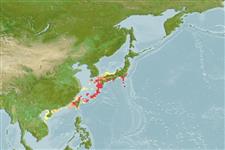Klassifizierung / Names
Namen | Synonyme | Catalog of Fishes(Gattung, Arten) | ITIS | CoL | WoRMS | Cloffa
>
Perciformes/Scorpaenoidei (Scorpionfishes) >
Aploactinidae (Velvetfishes)
Etymology: Cocotropus: Greek, kokkos = berry, seed + Greek, tropsis, tropo = turning (Ref. 45335); possi: Named for Dr. Stuart G. Poss, in recognition of his outstanding contributions to aploactinid systematics..
Environment: milieu / climate zone / depth range / distribution range
Ökologie
seewasser demersal. Temperate
Northwest Pacific: Japan.
Size / Gewicht / Alter
Maturity: Lm ? range ? - ? cm
Max length : 3.5 cm SL Männchen/unbestimmt; (Ref. 75210)
Kurzbeschreibung
Morphologie | Morphometrie
Rückenflossenstacheln (insgesamt): 8; Rückenflossenweichstrahlen (insgesamt): 7-8; Afterflossenstacheln 2; Afterflossenweichstrahlen: 7; Wirbelzahl: 26. This species is characterized by the following: D XIII, 8;, pectoral-fin rays 13; vertebrae 26; preopercular spines 5; upper jaw longer than lachrymal; fleshy papillae on posterior portion of maxilla absent; vomerine teeth absent; many well-developed fleshy papillae on ventral surface of lower jaw; first sensory pores on both sides of lower jaw separate; isthmus tip extending to level of between fourth and fifth sensory pores of lower jaw; body mostly uniformly dark brown (Ref. 75210).
Life cycle and mating behavior
Geschlechtsreife | Fortpflanzung | Ablaichen | Eier | Fecundity | Larven
Imamura, H. and G. Shinohara, 2008. A new species of Cocotropus (Teleostei: Aploactinidae) from the Ryukyu Islands, Southern Japan. Bull. Natl. Mus. Nat. Sci. Ser. A. Suppl. 2:21-24. (Ref. 75210)
IUCN Rote Liste Status (Ref. 130435)
Bedrohung für Menschen
Harmless
Nutzung durch Menschen
Mehr Information
NamenSynonymeMetabolismusRäuberÖkotoxikologieFortpflanzungGeschlechtsreifeAblaichenSpawning aggregationFecundityEierEientwicklung
Alter/GrößeWachstumLänge-GewichtLänge-LängeLängenhäufigkeitenMorphometrieMorphologieLarvenLarven Pop.Dyn.RekrutierungDichteBRUVS
ReferenzenAquakulturAquakultur ProfilZuchtlinienGenetikElectrophoresesVererbbarkeitKrankheitenVerarbeitungNutrientsMass conversion
PartnerBilderStamps, Coins Misc.LauteCiguateraGeschwindigkeitSchwimmstilKiemenoberflächeOtolithsGehirngrößeSehfähigkeit
Tools
Zusatzinformationen
Download XML
Internet Quellen
Estimates based on models
Preferred temperature (Ref.
123201): 20.3 - 23.4, mean 21.7 °C (based on 24 cells).
Phylogenetic diversity index (Ref.
82804): PD
50 = 0.5000 [Uniqueness, from 0.5 = low to 2.0 = high].
Bayesian length-weight: a=0.01000 (0.00244 - 0.04107), b=3.04 (2.81 - 3.27), in cm total length, based on all LWR estimates for this body shape (Ref.
93245).
Trophic level (Ref.
69278): 3.2 ±0.5 se; based on size and trophs of closest relatives
Fishing Vulnerability (Ref.
59153): Low vulnerability (10 of 100).
